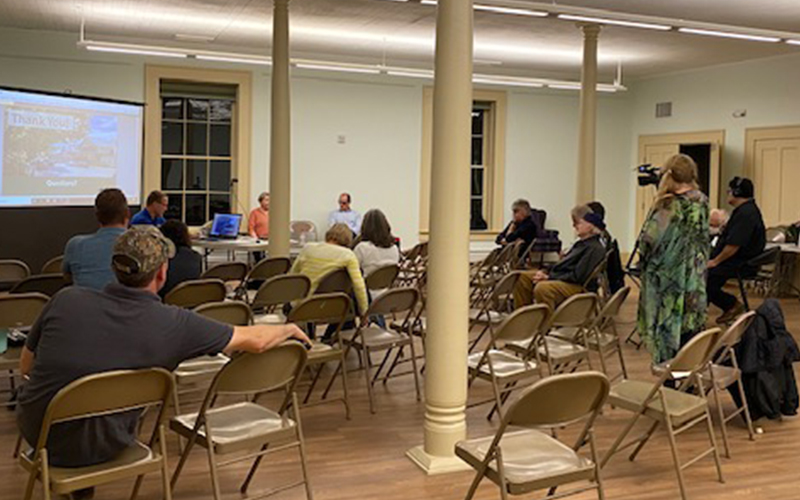“Any infrastructure is not sexy, costs a lot of money and takes a long time to build. But without we’re hamstrung,” noted Waitsfield Select Board member Chach Curtis at an October 26 meeting on the feasibility of developing community wastewater for Waitsfield.
Curtis, who is also a member of the Waitsfield Wastewater and Water feasibility study committee, continued, explaining that wastewater is one piece of what Waitsfield needs to increase infill development and increase housing in the town.
“Another piece is water and the good news is that 10 years ago we built a water system. Another key piece is zoning which was widely discussed at the recent housing summit. We got to where we are intentionally with our zoning ordinances. Right now the planning commission has a state grant to hire consultants to update our zoning laws – that project is underway. That’s a key piece of the puzzle too,” he said, adding that the town has already conducted a wetlands study in Irasville and Waitsfield Village.
STUDY AREA
The study area for the wastewater and water study extends from Tremblay Road to the north, to Kingsbury Road in the south, beyond the service area of the town’s municipal water system.
Curtis, who told those present at last week’s meeting that he was “here to whip you into a frenzy about wastewater,” asked those present how many felt the housing shortage in The Valley was impacting the sustainability of the community. He asked how that should be put in context of other issues such as wetlands and proximity to the Mad River.
Some of the findings from the 60% study report show that in the study area there are 260 properties and 100 of those properties have leach fields that are over 40 years old, another 50 properties have leach fields that are 20-40 years old.
‘POTENTIAL TIME BOMB’
“The design life of a leach field is only 20-30 years. That’s a potential time bomb for leach fields to fail. When a leach field fails wastewater gets into the ground water and surface water. In our historic village, wells are close to leach fields,” Curtis explained and said that failed leach fields can lead to well contamination as well as wastewater ending up in the Mad River.
“Upgrading a leach field can cost $30-$50,000 – think about that times 150 leach fields that are all going to need to be upgraded or replaced and we’re talking about over $5 million. That’s crazy, I’d rather put that $5 million into a community wastewater system. It’s a bigger benefit to the community if we solve it at the community level,” Curtis said.
He referred to a Town Plan section for Irasville and the village that calls for extensive infill development, noting again that the lack of wastewater capacity, combined with so many private wells and zoning that doesn’t support development is hindering housing.
‘LATE TO THE PARTY’
“We’re late to the party. So what are our options? How much will it cost? How will be pay for it?” he asked and added “We have the preliminary options in this 60% report and we’ll get more details on developing those options and costs in the 90% report.”
From there, the wastewater committee will make a recommendation to the select board and the community and the board will decide which option makes the most sense and pursue it, with some timelines projecting a Town Meeting 2024 bond vote.
Curtis noted that Vermont is awash in federal funds specifically earmarked for water and wastewater infrastructure projects.
“We have a generational opportunity to address the issue that challenges the sustainability of our community. We can build cost-efficient infrastructure by taking advantage of state and federal funding. It is totally do-able. Not tomorrow, but totally do-able,” Curtis said.
‘NEED COMMUNITY SUPPORT’
“The hard part involves you. We need community support. Talk about this with your neighbors, socialize these concepts so that it won’t be a big scary thing and we can get this done,” he added, reminding those present that 15 years ago, Waitsfield tried three times to secure voter approve for a community wastewater system about which not enough was known or communicated.
“We now get another chance and community engagement will make the difference,” he concluded before turning the meeting over to Jon Ashley of Dubois and King Engineering.
Ashley reported on the 60% completion of the feasibility study. That report was also presented to the select board last month. The report details several alternatives, including connecting more properties to the town water system, increasing capacity of existing wastewater systems, adding a new large capacity system, extending the water system to the south, developing clustered wastewater disposal sites with advanced pre-treatment and/or doing nothing.
The Dubois and King 90% feasibility study will be presented to the select board on December 12.












